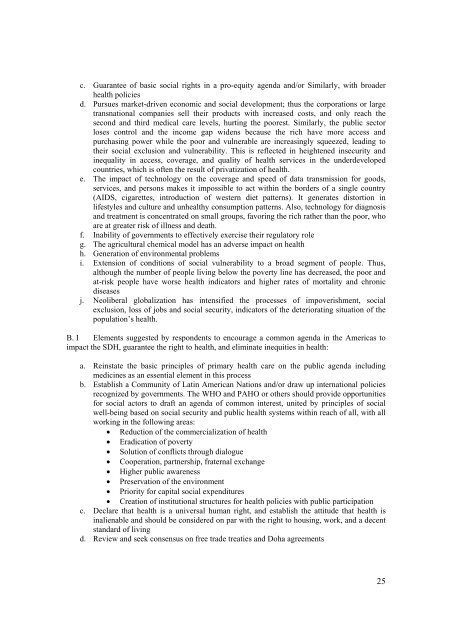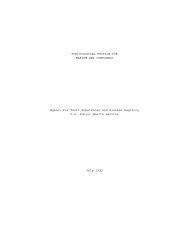REPORT ON THE SOCIAL DETERMINANTS OF HEALTH ... - bvsde
REPORT ON THE SOCIAL DETERMINANTS OF HEALTH ... - bvsde
REPORT ON THE SOCIAL DETERMINANTS OF HEALTH ... - bvsde
You also want an ePaper? Increase the reach of your titles
YUMPU automatically turns print PDFs into web optimized ePapers that Google loves.
c. Guarantee of basic social rights in a pro-equity agenda and/or Similarly, with broader<br />
health policies<br />
d. Pursues market-driven economic and social development; thus the corporations or large<br />
transnational companies sell their products with increased costs, and only reach the<br />
second and third medical care levels, hurting the poorest. Similarly, the public sector<br />
loses control and the income gap widens because the rich have more access and<br />
purchasing power while the poor and vulnerable are increasingly squeezed, leading to<br />
their social exclusion and vulnerability. This is reflected in heightened insecurity and<br />
inequality in access, coverage, and quality of health services in the underdeveloped<br />
countries, which is often the result of privatization of health.<br />
e. The impact of technology on the coverage and speed of data transmission for goods,<br />
services, and persons makes it impossible to act within the borders of a single country<br />
(AIDS, cigarettes, introduction of western diet patterns). It generates distortion in<br />
lifestyles and culture and unhealthy consumption patterns. Also, technology for diagnosis<br />
and treatment is concentrated on small groups, favoring the rich rather than the poor, who<br />
are at greater risk of illness and death.<br />
f. Inability of governments to effectively exercise their regulatory role<br />
g. The agricultural chemical model has an adverse impact on health<br />
h. Generation of environmental problems<br />
i. Extension of conditions of social vulnerability to a broad segment of people. Thus,<br />
although the number of people living below the poverty line has decreased, the poor and<br />
at-risk people have worse health indicators and higher rates of mortality and chronic<br />
diseases<br />
j. Neoliberal globalization has intensified the processes of impoverishment, social<br />
exclusion, loss of jobs and social security, indicators of the deteriorating situation of the<br />
population’s health.<br />
B. I Elements suggested by respondents to encourage a common agenda in the Americas to<br />
impact the SDH, guarantee the right to health, and eliminate inequities in health:<br />
a. Reinstate the basic principles of primary health care on the public agenda including<br />
medicines as an essential element in this process<br />
b. Establish a Community of Latin American Nations and/or draw up international policies<br />
recognized by governments. The WHO and PAHO or others should provide opportunities<br />
for social actors to draft an agenda of common interest, united by principles of social<br />
well-being based on social security and public health systems within reach of all, with all<br />
working in the following areas:<br />
• Reduction of the commercialization of health<br />
• Eradication of poverty<br />
• Solution of conflicts through dialogue<br />
• Cooperation, partnership, fraternal exchange<br />
• Higher public awareness<br />
• Preservation of the environment<br />
• Priority for capital social expenditures<br />
• Creation of institutional structures for health policies with public participation<br />
c. Declare that health is a universal human right, and establish the attitude that health is<br />
inalienable and should be considered on par with the right to housing, work, and a decent<br />
standard of living<br />
d. Review and seek consensus on free trade treaties and Doha agreements<br />
25

















